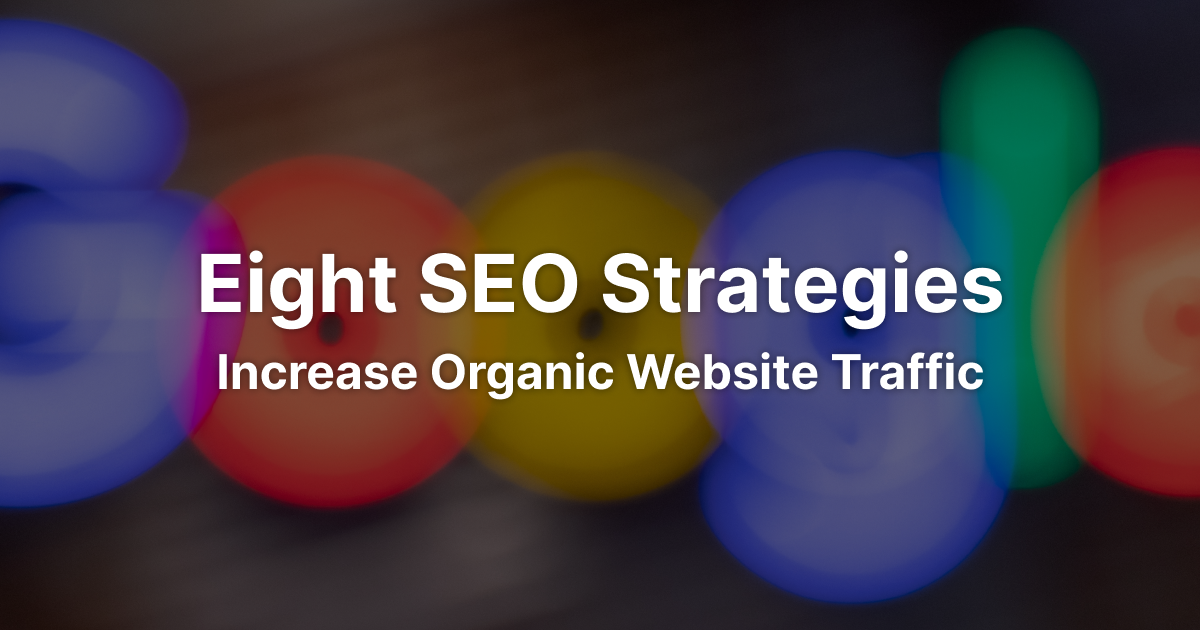
Eight SEO Strategies to Increase Organic Website Traffic in 2023
Increasing organic traffic is a top priority for online businesses aiming to succeed in the digital landscape. With the ever-growing competition and the need to rank higher in search engine results for targeted queries, brands worldwide strive to implement effective strategies to enhance their website's visibility and generate more traffic.
In this article, we will delve into eight SEO best practices that can help you stand out from the competition in the era of content saturation.

1. Identify the Right Keywords
Keyword research is the foundation of effective SEO. It's essential to identify the keywords that best represent your niche and create content around them. However, targeting high-volume keywords without considering their relevance to your business can be counterproductive. To avoid attracting irrelevant traffic, focus on building authority on keywords that align with your solutions and target audience.
Start by conducting comprehensive keyword research using tools like Google Keyword Planner, SEMrush, or Ahrefs. Look for keywords with a good search volume and moderate competition that closely relate to your products, services, or content. Long-tail keywords, which are more specific and have lower competition, can also be valuable in driving targeted traffic to your site.
Once you have identified the right keywords, incorporate them strategically into your website's content, meta tags, headings, and URLs. However, avoid keyword stuffing, as search engines penalize websites that engage in this practice.

2. Create Relevant and High-Quality Content
Creating informative, engaging, and relevant content is crucial for attracting organic traffic. Search engines value content that caters to topical depth and provides comprehensive answers to users' questions. By addressing your audience's queries in great detail, you can establish yourself as an authority in your niche and surpass your competitors in search rankings.
When developing content, consider the following guidelines:
a) Conduct Thorough Research: Gather accurate and up-to-date information from credible sources. Use reputable journals, studies, and industry reports to back up your claims and provide valuable insights.
b) Address Users' Pain Points: Understand your target audience and their pain points. Craft content that provides practical solutions to their problems, answers their questions, and offers actionable advice.
c) Maintain Consistency: Regularly publish fresh, high-quality content to keep your audience engaged and attract new visitors. Develop an editorial calendar and stick to a consistent posting schedule.
d) Use Different Content Formats: Experiment with various content formats, such as blog posts, videos, infographics, podcasts, and interactive quizzes. Different people prefer different formats, so diversifying your content can help you reach a wider audience.
e) Optimize for Readability: Format your content for easy readability. Use headings, subheadings, bullet points, and short paragraphs to break up the text. Incorporate relevant images and multimedia elements to enhance user experience.
Remember, the key to creating valuable content is to provide genuine value to your audience. When your content satisfies users' needs, they are more likely to stay on your site, share your content, and return for future visits.

3. Optimize Page Titles and Meta Descriptions
Page titles and meta descriptions play a crucial role in improving your website's visibility in search results and enticing users to click through. When optimizing these elements, it's important to consider the targeted keyword(s) and the searcher's intent.
a) Page Titles: Your page title should accurately reflect the content and purpose of the page while incorporating the targeted keyword(s). Keep the title concise, ideally within 50-60 characters (including spaces). A compelling page title increases the likelihood of attracting clicks from search engine users.
b) Meta Descriptions: Meta descriptions provide a brief summary of your page's content. Write descriptive, keyword-rich meta descriptions that entice users to click on your link. Aim for a length of around 150-160 characters (including spaces). While meta descriptions don't directly impact rankings, they can significantly influence click-through rates (CTR).
It's important to note that search engines may sometimes choose to display alternative titles and descriptions based on the search query. However, optimizing your page titles and meta descriptions increases the chances of displaying compelling and relevant snippets in the search results.

4. Optimize Images
Images play a vital role in enhancing the visual appeal and user experience of your website. They also offer opportunities for optimization to drive organic traffic.
a) File Size and Format: Optimize image file sizes to ensure fast loading times. Large image files can slow down your website, negatively impacting user experience and search rankings. Compress images without sacrificing quality using tools like Adobe Photoshop, TinyPNG, or Squoosh.
b) Image Names and Alt Text: Give your images descriptive file names that include relevant keywords. For example, instead of "IMG12345.jpg," use a filename like "organic-site-traffic-SEO.jpg." Additionally, include relevant keywords in the alt text attribute of the image tag. Alt text not only helps search engines understand the image content but also improves accessibility for visually impaired users.
c) Captions and Surrounding Text: Add informative captions to your images when appropriate. Captions provide additional context and can be indexed by search engines. Furthermore, surround your images with relevant textual content, such as headings, paragraphs, or bullet points. This helps search engines understand the context and relevance of the images.
d) Image Sitemaps: Create an XML sitemap specifically for images and submit it to search engines using the appropriate protocol (e.g., Google Search Console). Image sitemaps help search engines discover and index your images, increasing their visibility in image search results.
By optimizing your images, you can improve their visibility in image search results, attract more visitors, and enhance user engagement on your site.

5. Use Internal Links Effectively
Internal linking is the practice of linking to other pages within your website. It not only helps users navigate your site but also provides search engines with valuable information about the structure and hierarchy of your content. Here are some best practices for internal linking:
a) Link Relevant Keywords and Phrases: When creating internal links, use anchor text that is descriptive and relevant to the destination page. Avoid using generic terms like "click here" or "read more." Instead, use specific keywords or phrases that accurately describe the linked content.
b) Prioritize Topical Relevance: Link related pages and content together to establish topical relevance and demonstrate the interconnectedness of your website's information. This helps search engines understand the context and value of each page.
c) Balance the Number of Links: Be cautious not to overload your pages with too many internal links, as this can confuse users and dilute the importance of each link. Instead, focus on providing a logical and user-friendly linking structure.
d) Fix Broken Links: Regularly check for broken or outdated internal links and fix them promptly. Broken links not only negatively impact user experience but can also harm your website's SEO efforts.
By incorporating internal links effectively, you can enhance user experience, improve website navigation, and increase the visibility and authority of your pages in search engine rankings.

6. Optimize URLs
URL optimization is an often overlooked but essential aspect of SEO. Well-structured URLs can contribute to improved search engine visibility and user experience. Follow these best practices for URL optimization:
a) Keep URLs Concise: Create URLs that are concise, logical, and easy to read and understand. Avoid using lengthy URLs that contain unnecessary parameters, numbers, or special characters. A clear and straightforward URL structure helps search engines and users quickly comprehend the content of a page.
b) Include Targeted Keywords: Incorporate targeted keywords naturally into your URLs. However, exercise caution to maintain readability and avoid keyword stuffing. Use hyphens to separate words within the URL, as search engines interpret hyphens as word separators.
c) Use Canonical URLs: If your website has multiple versions of a page (e.g., HTTP and HTTPS, www and non-www), use canonical tags to specify the preferred version. Canonical tags inform search engines about the primary URL for indexing purposes, reducing the chances of duplicate content issues.
d) Redirect Old URLs: If you change a page's URL, set up appropriate redirects (301 redirects) from the old URL to the new one. Redirects ensure that users and search engines can still access the page even if they have bookmarked or linked to the old URL.
By optimizing your URLs, you improve the user experience, enhance click-through rates, and make it easier for search engines to crawl and understand your website's structure and content.

7. Improve Website Load Time
Website load time is a critical factor in both user experience and SEO. Users expect websites to load quickly, and search engines prioritize fast-loading sites in their rankings. Here are some strategies to reduce website load time:
a) Optimize Images: Compress and resize images without compromising quality. Use modern image formats like JPEG 2000 or WebP, which offer better compression while maintaining visual fidelity. Additionally, lazy loading images can significantly improve initial page load times.
b) Minify CSS and JavaScript: Reduce the file size of your CSS and JavaScript files by removing unnecessary characters, spaces, and comments. Minification tools and plugins can automate this process.
c) Enable Browser Caching: Leverage browser caching to store static resources, such as images, CSS files, and JavaScript, on the user's device. This reduces the number of requests sent to the server, resulting in faster subsequent page loads.
d) Use Content Delivery Networks (CDNs): CDNs distribute your website's content across multiple servers worldwide, ensuring that users can access your site quickly regardless of their geographic location. CDNs cache content closer to users, reducing latency and improving load times.
e) Optimize Hosting: Choose a reliable hosting provider that offers fast servers and robust infrastructure. Consider dedicated hosting or virtual private servers (VPS) for better performance compared to shared hosting.
Regularly test your website's load time using tools like Google PageSpeed Insights, GTmetrix, or Pingdom. Identify performance bottlenecks and implement necessary optimizations to deliver a seamless user experience and improve your search engine rankings.

8. Build High-Quality Backlinks
Building high-quality backlinks remains a crucial aspect of SEO. Backlinks from reputable and authoritative websites signal to search engines that your site offers valuable content and deserves higher rankings. Here are some tips for building quality backlinks:
a) Create Compelling Content: Develop exceptional, unique, and shareable content that naturally attracts backlinks from other websites. Infographics, in-depth guides, original research, and compelling blog posts are examples of content formats that have high link-building potential.
b) Guest Blogging: Contribute guest posts to authoritative websites in your niche. Include relevant links back to your own site within the content or author bio. Guest blogging allows you to showcase your expertise, gain exposure to a new audience, and earn valuable backlinks.
c) Influencer Outreach: Identify influencers and thought leaders in your industry. Engage with them, collaborate on content projects, and seek opportunities to earn backlinks through their networks.
d) Broken Link Building: Find broken links on relevant websites and offer your own content as a replacement. This method requires effort but can yield high-quality backlinks when executed effectively.
e) Monitor and Disavow Toxic Links: Regularly monitor your backlink profile to identify any low-quality or toxic backlinks. Disavow links from spammy or irrelevant sites using Google's Disavow Links tool to prevent them from negatively affecting your SEO.
Remember, the focus should be on acquiring natural and organic backlinks rather than resorting to manipulative tactics that violate search engine guidelines.
By implementing these SEO best practices, you can enhance your website's visibility in search results, drive organic traffic, and establish a strong online presence in 2023. Keep in mind that SEO is an ongoing process, so continuously monitor your site's performance, adapt to algorithm changes, and refine your strategies accordingly.